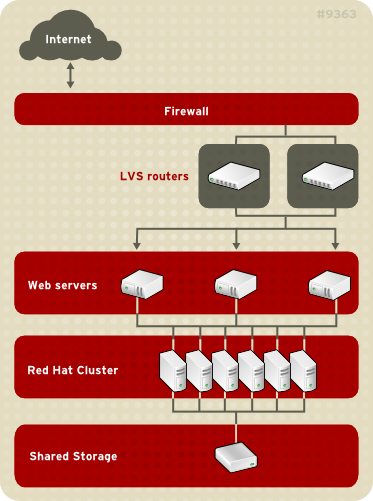부록 A. Red Hat Cluster로 LVS 사용
로드 밸런싱, 데이터 무결성, 어플리케이션 유용성을 제공하는 고가용성 전자상거래 사이트를 사용하기 위해 Red Hat Cluster와 함께 LVS 라우터를 사용할 수 있습니다.
The configuration in 그림 A.1. “LVS with a Red Hat Cluster” represents an e-commerce site used for online merchandise ordering through a URL. Client requests to the URL pass through the firewall to the active LVS load-balancing router, which then forwards the requests to one of the Web servers. The Red Hat Cluster nodes serve dynamic data to the Web servers, which forward the data to the requesting client.
그림 A.1. LVS with a Red Hat Cluster
Serving dynamic Web content with LVS requires a three-tier configuration (as shown in 그림 A.1. “LVS with a Red Hat Cluster”). This combination of LVS and Red Hat Cluster allows for the configuration of a high-integrity, no-single-point-of-failure e-commerce site. The Red Hat Cluster can run a high-availability instance of a database or a set of databases that are network-accessible to the Web servers.
3-tier 설정에는 역동적인 컨텐트를 필요로 합니다. 웹 서버가 (데이터 변경이 적은) 정적 웹 컨텐트를 사용할 경우 2-tier LVS 설정이 적합한 반면, 웹 서버가 역동적인 컨텐트를 사용할 경우 2-tier LVS 설정이 적합하지 않습니다. 역동적인 컨텐트에는 제품 재고, 구매 주문, 고객 용 데이터베이스가 있으며, 이는 고객이 정확히 업데이트된 정보로 액세스하는 지를 확인하기 위해 모든 웹 서버에서 일치되어야 합니다.
각각의 tier 구조에는 다음과 같은 기능이 있습니다:
- 첫번째 tier — 웹 요청을 배분하기 위해 로드 밸런싱을 실행하는 LVS 라우터
- 두번째 tier — 요청을 실행하는 웹 서버 모음
- 세번째 tier — 웹 서버로 데이터를 보내는 Red Hat Cluster
In an LVS configuration like the one in 그림 A.1. “LVS with a Red Hat Cluster”, client systems issue requests on the World Wide Web. For security reasons, these requests enter a Web site through a firewall, which can be a Linux system serving in that capacity or a dedicated firewall device. For redundancy, you can configure firewall devices in a failover configuration. Behind the firewall are LVS load-balancing routers, which can be configured in an active-standby mode. The active load-balancing router forwards the requests to the set of Web servers.
Each Web server can independently process an HTTP request from a client and send the response back to the client. LVS enables you to expand a Web site's capacity by adding Web servers behind the LVS routers; the LVS routers perform load balancing across a wider set of Web servers. In addition, if a Web server fails, it can be removed; LVS continues to perform load balancing across a smaller set of Web servers.
